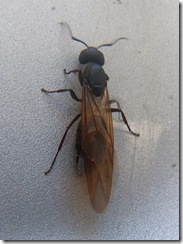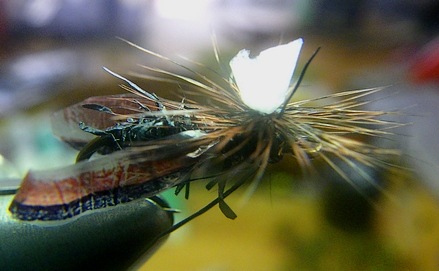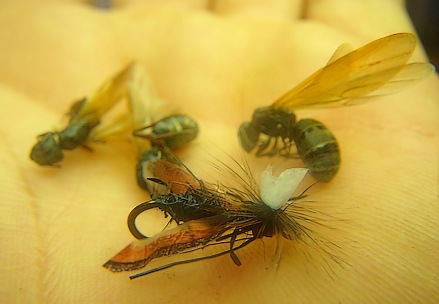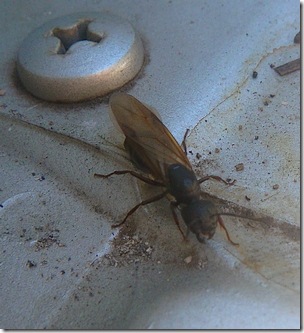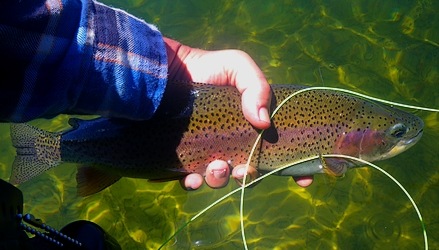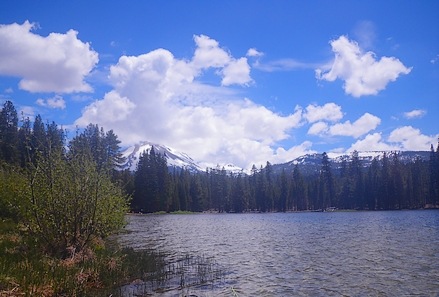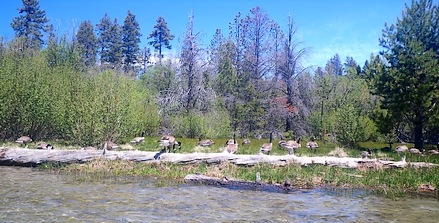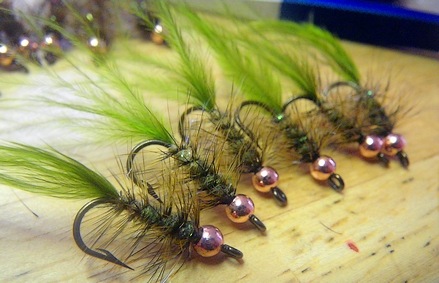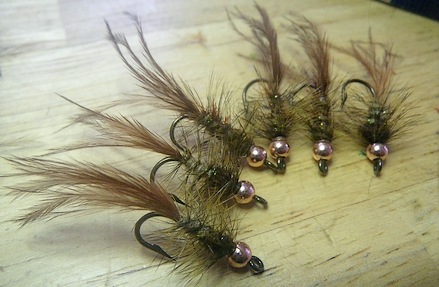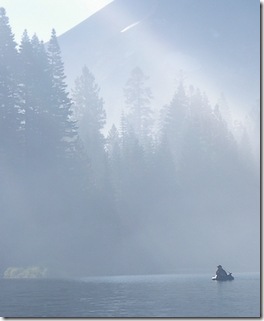 You’re looking down at the tailgate wondering “how’d my five weight line wind up on a System 6 reel, and why is the SOB set for left hand wind?”
You’re looking down at the tailgate wondering “how’d my five weight line wind up on a System 6 reel, and why is the SOB set for left hand wind?”
That’s when the cold prickly happens. Three hundred miles away from home, 20 miles from camp, and your buddy has his waders paused at his midsection looking at you expectantly, figuring you’re going to confess to an egregious screw up …
… and he’s not far wrong.
That awesome eBay score where you landed a System 6 for under fifty bucks, with an oxidized Cortland SL line in light green (which matches the color of your floating #5 on the correct reel), with a leader butt resembling a buggy whip, whose nail knot just parted when you sneezed on it …
That’s what you’ll be fishing with for the next four days.
… and if you can’t make it serviceable with the contents of your truck, assisted by a generous and overflowing parking lot garbage can, you’ve been domesticated to the point where anything involving sunshine is risky.
A nine foot leader comprised of eighteen inches of butt and seven foot of tippet might raise an eyebrow in traditional circles, but not in the pre-dawn abyss that is necessity.

I likened it to a black cloud trip, where everything you fear most shows itself in a long string of misfortunes.
By day two I actually preferred my new leader, and reeling left handed. Only a couple of fish had attempted to break the long reverie of finning, stripping, and casting, and seven foot of tippet allows unparalleled sinking for nymphs and leeches.
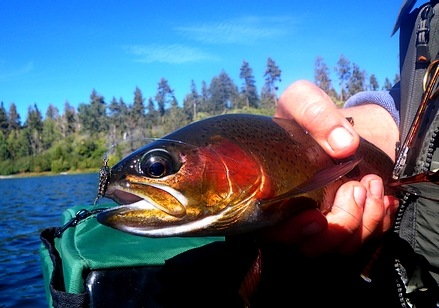
Swim fins require you walk backwards when making the transition from water nymph to terrestrial bi-ped. That round piece of driftwood I stepped on while backing out of the lake was an instant takedown, and trapped in fins those big feet stayed pointing North, while the rest of me landed South.
I’m laying there groaning and holding the knee that got folded under and failed to rotate with all that falling flab, recognizing that the solution set was the same as the earlier calamity of the reel …
If you can’t make it serviceable with the contents of the truck, assisted by a generous and overflowing …
As fortune would have it, side to side stabilization was affected but finning my way through the lake was pain free, permitting me to endure 14 more hours fruitless finning and much casting.
Slowly and inexorably that black cloud began to lift. It started imperceptibly with the discovery of two dozen flies bobbing in the shore grasses, still viable in their The Fly Shop container. 110 meters of fluorocarbon tippet bobbed nearby, likely both donated to Davy Jones in a fit of pique. While feeling for my unknown benefactor, I helped myself accordingly.
The final straw was the hour-long nap under the shade of the bank side bushes, completely forbidden, a hideous and shameful luxury, and I’m woken by Kelvin’s involuntary cry – who’d paddled over to see why them big feet protruding from the brush hadn’t moved in a fortnight – and something large and wild had ate his bug and delayed my rescue.
… nice to know that eventually someone would find the body.
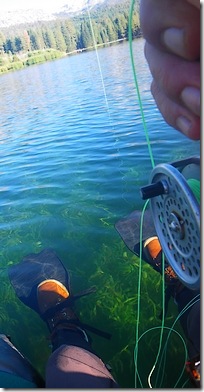 Why you resist the urge for 6X
Why you resist the urge for 6X
It’s as brushy and formidable as the willows and pines lining the bank. A lush green forest both above water and below.
Matching tippet to conditions yields more hooked fish, but it leads to even more heartbreak later. The scene at left demonstrates why swimming a nymph between those underwater “pines” might make 4X the better choice.
Freshly invigorated from my nap and in twenty feet of water, my innocent little bug was inhaled by something fierce and predatory.
A couple of throbs on the rod and it was dormant – intertwined with the fibrous vertical weed. The adrenalin of the initial grab quickly wears off with grim reality replacing it, yet the resolve of sticking with the heavy leader means there’s a chance…
Slim, made even slimmer if you don’t test your knots frequently.
Clearheaded and resolved to shake chance from the equation, and emboldened by the momentum swing in my direction, it had been my first thought once back on the bridge …
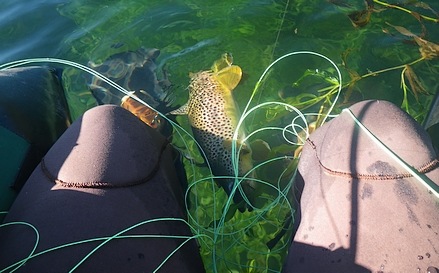
… and I thanked my vigilance, as I wrenched up a big yellow-bellied brown with a yen for deep, no match for momentum shift, 40 winks, and fresh knots.
We revisit the Old Gal in her Dotage
Kelvin and I snuck over to my alma mater to pay the old gal a bit of respect. With the lake fishing slow, and Hat Creek only a bit further, it was a nice opportunity to stretch the legs while I revisited the creek that had aided me in learning flat water – and how easy a spring creek can humble even the best angler.

Change was everywhere, starting with empty parking lots and new bathrooms, and magnified by a forest fire that had ripped through the watershed.
Gone were all the placards espousing wild trout and CalTrout’s involvement – replaced by run of the mill lectures from DF&G or PG&E. As CalTrout’s website lacks any mention of the creek or the wonderful project they initiated, I’m left wondering whether Hat Creek isn’t some soiled dove they’re attempting to disavow.
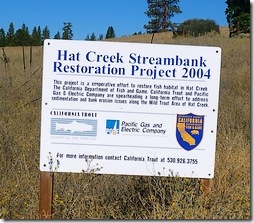 Bank stabilization efforts were dated 2004, and while all those wading feet had removed 100 feet of the Powerhouse stretch – dumping it into the flat water below, placards at Carbon Bridge suggested the consortium of CalTrout, Pg&E, and Fish & Game was still active.
Bank stabilization efforts were dated 2004, and while all those wading feet had removed 100 feet of the Powerhouse stretch – dumping it into the flat water below, placards at Carbon Bridge suggested the consortium of CalTrout, Pg&E, and Fish & Game was still active.
I keep thinking of all those cleated rubber soles and how they’ll accelerate the problem, in the very places we revere most.
Carbon Bridge was as menacing as ever, but the slug of silt that played havoc with the creek many years ago was still very much evident. This former Holy Water was responsible for thrown rods, complete and total frustration, and was an inescapable draw for those that fancied a single grab from large and difficult fish.

I spent summers on the far bank, mostly walking away muttering that I’d never return, but stubborn would get the best of me each evening.
Now it’s home to small fish, who were evident as they dined on the light smattering of spinners that comprised the morning grab.
We turned tail and ran.
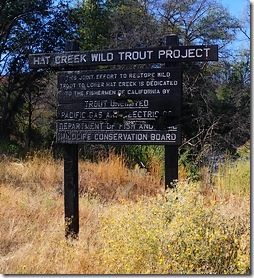
The entire stretch below Hat Creek Park had been burned badly and showed the effects of salvage logging.
I showed Kelvin the fish weir that marked the end of the trophy water, and even the sign had been consumed by flames.
Absent the shade of all those pines, the march back to the parking area was a blistering hellish moonscape. All the slopes leading down to the creek are matchsticks and once logged of the evergreen timber, will take many years to restore, if ever.
The oaks that give shade and cover to the creek were mostly intact, but even these weren’t spared.
It was a bit melancholy for a homecoming, but that was shortlived. Memories of all those good friends and better times were ever present, as every tree could still boast of owning a half dozen of my flies in the lower branches, there to rust with those of pals, now gone.
… and I still had a trick or two up my sleeve.
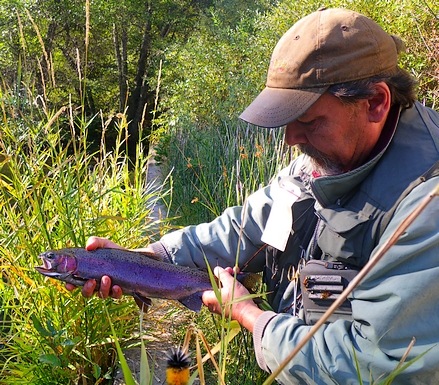
Momentum was on my side, or perhaps it was the Ghost of What Once Was. The Old Gal is burned and wounded, perhaps a bit neglected, but there’s large fish left, as the above “hero” shot describes.
If I had squeezed in a nap they’d have been twice as big.
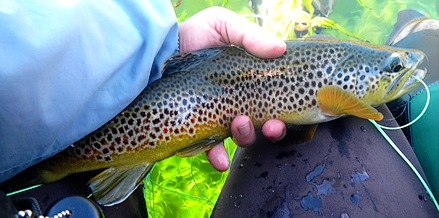
Four days and a couple of memorable book-ends to the expedition, good company, and explains my silence of last week. I’ll have a bit more on the experimentals that slayed these dragons, but have to craft a note to friend Chandler – who’s halfway across the country while I’m pillaging his backyard …
Technorati Tags:
brown trout,
fly fishing momentum,
scientific anglers system six,
left hand wind,
Lassen National Forest,
Hat Creek,
Powerhouse #2 riffle,
Carbon Bridge,
Rainbow trout,
fly fishing for trout,
gimped knee
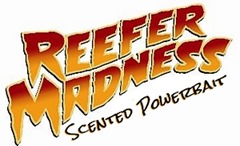 Now there’s more reason to “Go West, Young Man” – given as how Oregon, Colorado, and California are soon to upstage Alaska, New Zealand, and Argentina as the last bastions of pure angling body count …
Now there’s more reason to “Go West, Young Man” – given as how Oregon, Colorado, and California are soon to upstage Alaska, New Zealand, and Argentina as the last bastions of pure angling body count …



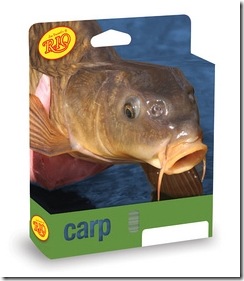 Dire news on climate change suggests that Western US and particularly the Yellowstone basin are already in the grip of a warming trend, and warming quicker than the rest of the continental US.
Dire news on climate change suggests that Western US and particularly the Yellowstone basin are already in the grip of a warming trend, and warming quicker than the rest of the continental US. You’re looking down at the tailgate wondering “how’d my five weight line wind up on a System 6 reel, and why is the SOB set for left hand wind?”
You’re looking down at the tailgate wondering “how’d my five weight line wind up on a System 6 reel, and why is the SOB set for left hand wind?”

 Why you resist the urge for 6X
Why you resist the urge for 6X

 Bank stabilization efforts were dated 2004, and while all those wading feet had removed 100 feet of the Powerhouse stretch – dumping it into the flat water below, placards at Carbon Bridge suggested the consortium of CalTrout, Pg&E, and Fish & Game was still active.
Bank stabilization efforts were dated 2004, and while all those wading feet had removed 100 feet of the Powerhouse stretch – dumping it into the flat water below, placards at Carbon Bridge suggested the consortium of CalTrout, Pg&E, and Fish & Game was still active.



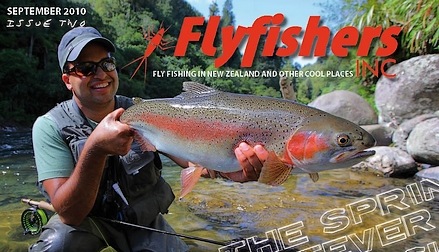
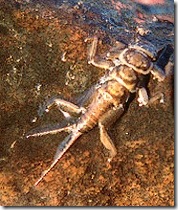 Confirmation of what we’ve always suspected, that with the climb in water temperature due to summer’s heat, and corresponding decline in dissolved oxygen, that stoneflies migrate to the faster flows where the oxygen is again plentiful.
Confirmation of what we’ve always suspected, that with the climb in water temperature due to summer’s heat, and corresponding decline in dissolved oxygen, that stoneflies migrate to the faster flows where the oxygen is again plentiful.